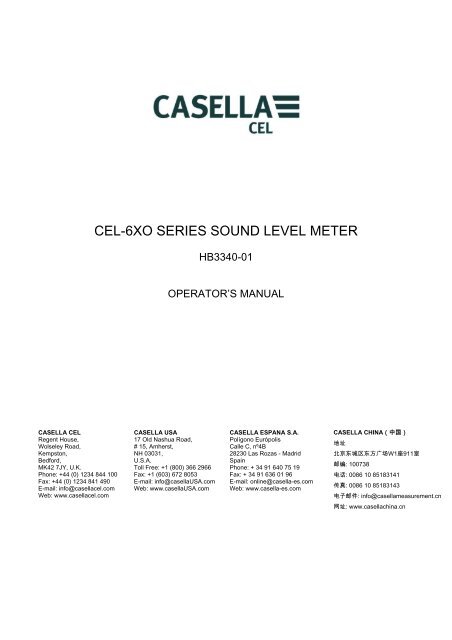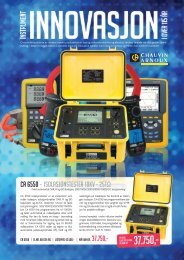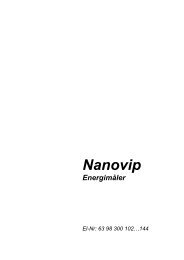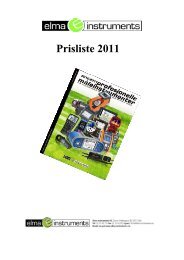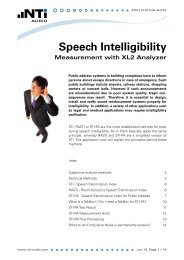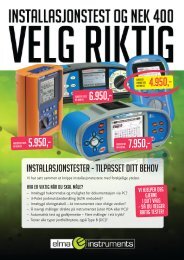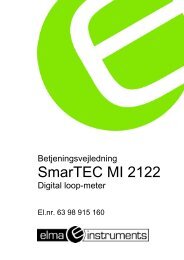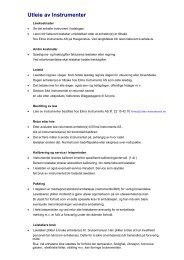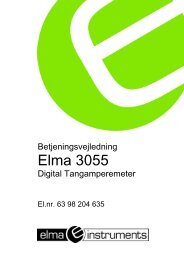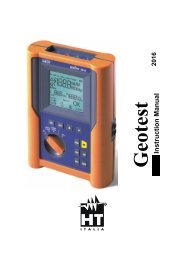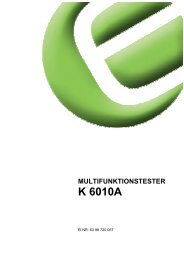FLEID GUIDE FOR CEL-6XO Series Sound ... - Elma Instruments
FLEID GUIDE FOR CEL-6XO Series Sound ... - Elma Instruments
FLEID GUIDE FOR CEL-6XO Series Sound ... - Elma Instruments
You also want an ePaper? Increase the reach of your titles
YUMPU automatically turns print PDFs into web optimized ePapers that Google loves.
<strong>CEL</strong>-<strong>6XO</strong> SERIES SOUND LEVEL METERHB3340-01OPERATOR’S MANUALCASELLA <strong>CEL</strong>Regent House,Wolseley Road,Kempston,Bedford,MK42 7JY, U.K.Phone: +44 (0) 1234 844 100Fax: +44 (0) 1234 841 490E-mail: info@casellacel.comWeb: www.casellacel.comCASELLA USA17 Old Nashua Road,# 15, Amherst,NH 03031,U.S.A.Toll Free: +1 (800) 366 2966Fax: +1 (603) 672 8053E-mail: info@casellaUSA.comWeb: www.casellaUSA.comCASELLA ESPANA S.A.Polígono EurópolisCalle C, nº4B28230 Las Rozas - MadridSpainPhone: + 34 91 640 75 19Fax: + 34 91 636 01 96E-mail: online@casella-es.comWeb: www.casella-es.comCASELLA CHINA( 中 国 )地 址北 京 东 城 区 东 方 广 场 W1 W1 座 911 911 室邮 编 :: 100738电 话 :: 0086 008610 10 85183141传 真 :: 0086 008610 10 85183143电 子 邮 件 :: info@casellameasurement.cn网 址 :: www.casellachina.cn
2Casella <strong>CEL</strong> Limited
TABLE OF CONTENTSSECTION TITLE PAGE1 Introduction 42 Instrument Features 43 Operation 74 Storage 195 Specifications 226 Servicing and Warranty Arrangements 277 Appendix 28Casella <strong>CEL</strong> Limited 3
1. INTRODUCTIONThe <strong>CEL</strong>-6X0 <strong>Sound</strong> Level Meter has been designed to meet the demands ofworldwide industrial health and safety professionals as well as general noisemeasurement applications. The instrument encompasses functionality from basicsound level measurement to integrating and real-time octave band analysis.The <strong>CEL</strong>-6X0 instrument is based on the very latest digital signal processingtechnology and has a crisp, vibrant colour TFT LCD display. This precisioninstrument is designed to bring your noise measurements up to date giving confidentand reliable performance fully compliant with international standards.Data is stored in a .csv format, compliant with MS Office applications, and throughthe USB connection, the .csv files can be copied to a PC without the need for anypropriety software packages.Back to Index2. INSTRUMENT FEATURESThe <strong>CEL</strong>-6X0 <strong>Sound</strong> Level Meter is available in two variants.<strong>CEL</strong>-620AAn broadband integrating meter providing A, C, and Z frequency weightings, FastSlow and Impulse time weightings with cumulative storage and PC connectivityfunctions. A single measurement range of 140dB RMS is standard. SimultaneousL Aeq and L Ceq values are measured for use in the HML selection of hearing protectionmethod. L avg is available with a selectable threshold. This model is available in Class1 or Class 2 accuracy standards.<strong>CEL</strong>-620BThe ultimate model providing ‘Integrating’ functionality combined with addition ofOctave band analysis. This instrument is designed to satisfy the demands of allindustrial noise at work applications. Octave results may be displayed graphically orin numerical form and can be A, C or Z frequency weighted. Advanced DSPprocessing provides fast parallel processing of Octave results from 16Hz to 16KHz.This model is available in Class 1 or Class 2.DESCRIPTION (Refer to Figure 1)The <strong>CEL</strong>-6X0 has a compact, ergonomic and robust ‘rubber grip’ case design thatsits the instrument comfortably in the hand when not mounted on a tripod. The ½”microphone (1) can be removed from the fixed preamplifier (2). The windshleid (1)should be used to cover and protect the microphone at all times.When the instrument is switched ON (3) it will run through its own softwareinitialisation and then default to a Stop mode (Red Bar) screen.To navigate within a screen use the Cursor Keys (6). Not all the screens havenavigable fields on the display. To navigate from one screen to another, use the SoftKeys (5). To start a ‘run’ (measurement), press the Start key (7); to stop the runpress the same key again.The instrument has a single measurement range to 140dB (RMS) and 143.3dB (C)peak. No range adjustment is needed which greatly simplifies operation.The <strong>CEL</strong>-6X0 can be ‘explored’ just like a USB memory device and the data files ofthe individual measurements are saved in a .CSV (Comma Separated Variable)format that is compatible with MS Office applications. This means that no softwareneeds to be installed onto a PC to retrieve the data.4Casella <strong>CEL</strong> Limited
The <strong>CEL</strong>-6X0 measures all the required parameters simultaneously with the requiredfrequency and time weighting.1 – Windshield (covering removable microphone), 2 – Fixed Pre-amplifier,3 – ON/OFF Key, 4 – Display, 5 – Soft Keys, 6 – Navigation Cursor Keys,7 – Run/Stop Key.Back to IndexFigure 1 <strong>CEL</strong>-6X0 <strong>Series</strong>Casella <strong>CEL</strong> Limited 5
BATTERY INSTALLATION (Refer to Figure 2)CAUTION: The batteries can be zinc carbon, alkaline or rechargeable. Do notmix battery types.The <strong>CEL</strong>-6X0 Instrument requires three AA batteries. Remove the batterycompartment cover. Check correct polarity. Fit the batteries. Refit the battery cover.Press and release the ON/OFF Key. Check the battery condition symbol shows thebattery has a good charge.Back to IndexFigure 2 Battery Charge Indicator and Battery Installation.6Casella <strong>CEL</strong> Limited
3. OPERATIONA. SWITCH ON the <strong>CEL</strong>-6X0 INSTRUMENT (Refer to Figure 3)The instrument software screens have been designed with colour coded top andbottom bars to enable the user to know at a glance which part of the firmware(operating system) is currently being accessed.Colour coding is as follows:RED – Stop screens. These screens are displayed when the instrument hascompleted initialisation after power-up, as well as prior to taking a measurement run.BLUE – Setting screens. These screens are used to set up the instrument correctlyand includes settings such as date and time, language and backlight.LIGHT BLUE – Memory Results screens. This is where the results frommeasurement runs are viewed.GREEN – Run screens. These screens show a measurement run is in progress.Measured values are stored in the Memory Results.YELLOW – Calibration screen. This screen is automatically displayed uponapplication of a 1KHz Acoustic Calibrator. This is where the instrument is calibratedprior to a run.This is a precision instrument and should be calibrated before use to ensureaccurate measurements.<strong>CEL</strong>- 620A – When the instrument is powered up, the initialisation screen will bedisplayed first, followed by the Graph screen in the STOP mode (red bars). Press theMENU Key (A) to access the MENU screen.<strong>CEL</strong>- 620B – When the instrument is powered up, the initialisation screen will bedisplayed first, followed by the Octave screen in the STOP mode (red bars). PressVIEW to see the Graph screen. Press the MENU Key (A) to access the MENUscreen.Figure 3 Switch ON the <strong>CEL</strong>-6X0Casella <strong>CEL</strong> Limited 7
B. SETTINGS SCREENS (Refer to Figure 4)Note: Press EXIT (A) at any time to go back to the previous screen.SETTINGSThe Settings menu allows configuration of instrument 6X0 setup, time/date,language, backlight, run duration timer and calibration level.Use Cursors (C) to select the Settings icon (1) and press Select (B).6X0 SETUPThis menu allows selection of the parameters to be viewed during a measurementrun. Note that regardless of the measurement view selected, all parameters will bestored simultaneously and can be viewed via a PC. Use cursors (C) to highlight 6X)SETUP icon and press (B).MEASUREMENT VIEW.Four predefined views are available to satisfy measurements for internationalworkplace noise legislation. Use the cursor keys (C) to select the required view andpress (B) to activate the measurement view. The Measurement View with the wordACTIVE next to it will be used for measurement runs. To view the details press View(B).USER 1 AND 2 SETTINGS.Two customiseable views are available in which measurement weightings andparamaters can be set. When one of these views is Active by pressing the (B) key,press (B) again to edit the view. Left right cursor keys are used to make changesand up/down cursor keys are used to move to the next field. On this screen you candefine the following:RESPONSE (Random/Freefield)Random response is typically used to conform to US legislation for workplace noisewhereas Freefield is used throughout the EU.LAVG THRESHOLD (70-90dB)The threshold is used for the calculation of L AVG , which is the level at which all noisebelow is ignored. Note with threshold set to zero the threshold is off.OCTAVE WEIGHTING (A, C or Z)The frequency weighting used to display octave band results. Note that regardless ofthe settings selected, Z weighted measurements are stored so the data can be postprocessed on a PC to C or A weighting.OCTAVE TIME CONST (F or S).The time weighting used to display octave band results. Regardless of the selection,both time weightings are stored simultaneously for L MAX results. Time weightings ofFast (F) or Slow (S) do not apply to L eq measurements.8Casella <strong>CEL</strong> Limited
Press (D) to restore defaults. Press (B) to open the Functions screens for theselected ‘User 1 View’.Figure 4 Setting Options (Sheet 1)USER 1 AND 2 MEASUREMENT PARAMETERSThe Functions screens allow the Operator to select up to nine functions for themeasurement ’run’. A counter replaces the battery level indicator at the foot of thescreen. The counter displays the number of parameters selected.Press the Functions key (B) and use the cursor keys (C) to navigateup/down/left/right.The first screen shows <strong>Sound</strong> Pressure Level (SPL) and L eq values. The parametersdisplayed during a measurement run are highlighted in green.The Main SPL value is highlighted in red, which is the SPL value shown in Stop andRun modes. To select the Main value press and hold the Run/Stop key (D) until theparameter is highlighted in red.Other parameters can be added. Navigate to the appropriate parameter that is to beadded. A rectangle indicates the selected parameter. Press the Run/Stop key (D) toselect the parameter. The parameter is highlighted green to show it is selected.Repeat for any subsequent parameters that need to be selected and access theadditional screen by pressing the More key (B). Press Back (A) to exit and anychanges will be automatically saved.Casella <strong>CEL</strong> Limited 9
Figure 4 Settings Options (Sheet 2)10Casella <strong>CEL</strong> Limited
C. DATE AND TIME SCREENS (Refer to Figure 5)SETTINGSFrom the Menu select the Settings icon (1) and press (B) to select.SET CLOCKUse the cursors (C) to select the Set Clock icon and press (B) to select.SET TIMEThe screen will be displayed with the Time highlighted. To set the time press Edit (B).The hour will be highlighted. Adjust the hour setting use the Up/Down cursors. Pressthe cursor key (C) to highlight the minutes. Adjust the minutes setting use theUp/Down keys. Press the cursor key (C) to highlight to the seconds. Adjust theseconds setting use the Up/Down keys. When the correct time has been set, pressSave (B).SET DATEPress Cursor Key (C) to move the highlight to the date. Press Edit (B) The day will behighlighted. Change the day setting use the Up/Down keys. Press the cursor key (C)to highlight the month. Adjust the month setting use the Up/Down keys. Press thecursor key (C) to highlight to the year. Change the year setting use the Up/Downkeys. When the correct time has been set, press Save (B).CLOCK SET. The time and date is now set. Press EXIT to go back to the Set Clockscreen.Figure 5 Set Date and TimeCasella <strong>CEL</strong> Limited 11
D. SET LANGUAGE (Refer to Figure 6)LANGUAGEFrom the Menu select Settings (1). Use the cursor keys (C) to navigate to the Worldicon (2). Press Select (B).Use cursors (C) to select the desired language and press (B) to select. Press Exit(A) when finished.Figure 6 Set LanguageE. SET BACKLIGHT (Refer to Figure 7)BACKLIGHTFrom the Menu select Settings (1). Use the cursor keys (C) to navigate to theBacklight icon (2). Press Select (B).Figure 7 Set Backlight (Sheet 1)ACTIVATION. The screen will be displayed with the Activation symbol highlighted. Toset the Activation mode press Edit (B). Use the cursor keys (C) to toggle between thefollowing backlight modes:KEYPRESS- The backlight stays on for a set Duration following any key press.ON- Backlight remains on continuously. If the ON option is selected the Durationsetting will be disabled.12Casella <strong>CEL</strong> Limited
F. SET RUN DURATION (Refer to Figure 8)RUN DURATIONThe Duration timer allows measurements runs to be performed over a specified time.At the end of this time the measurement will automatically be stopped. From theMenu select Settings (1). Use the cursor keys (C) to navigate to the Run Durationicon (2). Press Select (B).DURATION TIMERPress (B) to edit the Duration timer to either On or Off and use cursors (C) to changethe selection. Press Save (B) to continue.Figure 8 Run Duration (Sheet 1)DURATION. Press cursor key (C) to navigate to the Duration field. Press Edit (B) tochange the Duration time. Use the Up/Down cursors (C) to make changes asrequired.Press Save (B) to save the changes. Press Exit (A) Settings screen.Figure 8 Run Duration (Sheet 2)14Casella <strong>CEL</strong> Limited
G. CAL. REF. LEVEL (Refer to Figure 9)Note: For Instrument Calibration refer to Section J – Calibration Screens.CAL. REF. LEVELThe Calibration Reference Level is used to set the instrument’s calibration level tothe exact level of your calibrator. Calibration levels can be set from 93-95dB or 113-115dB. A 1KHz calibrator must be used.From the Menu select Settings (1), use the cursor keys (C) to navigate to the Cal.Ref Level icon (2). Press Select (B).The Calibration Reference Level (Cal. Ref. Level) screen will open with the last levelused for calibration. Press Edit (B) to alter the level.The first digit can be selected 0 or 1 only, other digits can be 0-9. Use cursor keys(C) to make changes as required and press (B) to save changes.Press Exit (A) to go back to the Settings screen.Figure 9 Calibration Reference LevelCasella <strong>CEL</strong> Limited 15
H. VIEW MEMORY RESULTS (Refer to Figure 10)This is where the results from completed measurements are stored. The MemoryResults are stored in a chronological order, with the latest measurement at the top ofthe list.MEMORY RESULTSFrom the Menu screen, use the cursor keys to select the Memory Results icon (1).Press Select (B) to access the memory.Use the Up/Down cursors (C) to navigate the listed results. When a Memory Resulthas been selected, press Select (B) to access the measurement.This screen gives the operator the choice to view the selected memory result, or todelete it. Use the left/right cursor keys (C) to select View and press Select (B).The Results screen displays an overview of measurement data for the selected run.This is read only. To see the specific results, press View (B).Figure 10 View Memory Results (Sheet 1)The Octave values (<strong>CEL</strong>-620B only) saved in the memory Result are displayed in agraphical format. Use cursor keys (C) to move the cursor (1) across the graph. Eachgraph bar represents an octave band measured in Hz or KHz.Use the up/down cursors keys (C) to toggle between parameters such as LMAX andLAEQ (2).To view the numerical results (<strong>CEL</strong>-620B only), press View (B).Press EXIT (A) to leave the Memory Results or VIEW (B) to cycle the MemoryResults screens again.16Casella <strong>CEL</strong> Limited
Figure 10 View Memory Results (Sheet 2)I. DELETE MEMORY RESULTS (Refer to Figure 11)From the chronological list of measurement runs, use the Up/Down cursors (C) tonavigate the listed results. When a Memory Result has been selected, press Select(B) to go to the next screen.This screen gives the operator the choice to view the selected memory result, or todelete it. Select Delete and press Select (B).This screen asks the operator to either delete only the current run or to delete all themeasurement runs within the memory. Use the cursors (C) to make the requiredselection and press (B) to Select. The next screen asks for final confirmation topermanently delete the Memory Result. Press (A) to confirm. The Memory Result willbe permanently deleted. If not sure, press (B) to go back the Memory Results list.Figure 11 Delete Memory ResultCasella <strong>CEL</strong> Limited 17
J. RUN SCREENS (Refer to Figure 12)The Instrument has four Run screens: The Main screen, the Graph screen, theOctaves screens and the Octaves Values screen, the last two of which are onlyavailable on the <strong>CEL</strong>-620B.Switch ON the instrument as detailed in Figure 3.<strong>CEL</strong>-620A – Press the RUN/STOP Key (D) to go to the Graph screen.<strong>CEL</strong>-620B – OCTAVE screen. Press the RUN/STOP Key (D) to go to the Octavesscreen.<strong>CEL</strong>-620A and <strong>CEL</strong>-620B – The “Play” symbol is displayed in the top left handcorner of the screen. The “Pause” symbol is in the bottom left hand corner of thescreen. The left hand Soft Key (A) is the PAUSE/RUN feature. When Pause isselected, ‘PAUSED!’ will be displayed on the screen. The incremental run numberand duration are displayed in the top right hand corner of the screen. If the RunDuration Timer is set, a ‘stopwatch’ icon will appear next to the countdown timer. TheRun Duration timer is enabled and disabled in SETTINGS (Refer to Figure 8). If theRun Duration is not set, the digital timer will count up until the run is stoppedmanually (by pressing D).Figure 12 Run Screens<strong>CEL</strong>-620A (Refer to Figure 13). The broadband values can be viewed as abargraph on the Main screen, or as a graphical time history on the Graph screen.Pressing View key (B) toggles between Graph and Main screens.18Casella <strong>CEL</strong> Limited
Figure 13 <strong>CEL</strong>-620A Run Screens<strong>CEL</strong>-620B (Refer to Figure 14).The <strong>CEL</strong>-620B provides two additional octave screens shown in Figure 14. Use theView key (B) to toggle the four available screens. Use the left/right cursor keys (C) tomove across the frequency bands (1) when in graphical view. Use up/down cursorkeys (C) to toggle between LMAX and LEQ parameters (2).Each graph bar represents an octave band measured in Hz or KHz. To view a tableof the octave values, press View (B).Figure 14 <strong>CEL</strong>-620B Main Run ScreensK. INSTRUMENT CALIBRATION (Refer to Figure 15)Note: The Instrument must be at a STOP screen before the Acoustic Calibrator isfitted.Calibrations should be performed before and after measurements. Fit the acousticcalibrator over the removable microphone and push it home. Switch the calibrator onusing ON/OFF Key (1). The Instrument detects the signal and automatically activatesthe calibration screen (yellow bars). Press (B) to begin calibration. The instrument willbe calibrated and the word PASSED displayed. A ‘calibration change’ value is shownat the bottom of the screen. This identifies the change since the previous calibration.Remove the acoustic calibrator. Press EXIT (A) to go back to the Stop screen. Pressand hold the acoustic calibrator ON/OFF Key to switch the calibrator off.Casella <strong>CEL</strong> Limited 19
Figure 15 Instrument Calibrationl. EXTRACTING DATA (Refer to Figure 16)Each measurement run is stored as a file within the <strong>CEL</strong>-620 in a .CSV format. Thisformat will automatically open with MS EX<strong>CEL</strong> or similar office applications. The filesare named consecutively from 1 to 100, so the first run will be named R001.CSV. Allmeasurement parameters are contained within these files, regardless of thedisplayed parameters selected within the instrument setup.The <strong>CEL</strong>-620 acts as a removable storage device when connected to a PC by theCMC51 cable. See Figure 18 below for the location of the USB connection on the<strong>CEL</strong>-620. Once connected, the PC will automatically detect the instrument isconnected and within a few seconds have installed the necessary drivers. AnExplorer window will open on the PC to show the files on the instrument. Simplycopy the files to your PC as required.Figure 16 Measurement Data Files20Casella <strong>CEL</strong> Limited
J. SYSTEM TOOLS (Refer to Figure 17)The system tools menu can be accessed from the startup screen by pressing theleft/right cursor keys (C) together. Note that these functions need not be used withingeneral operation and stored results will be lost if incorrectly used. Their primaryfunction is for calibration laboratories or diagnostic purposes. Three options areavailable:‘Recover USB Disk Files’ copies files stored in the backup E 2 memory to the USBdisk.‘Set USB Disk R/W’ allows the mass storage device to have data written to it. Notethat this is primarily used for testing purposes.‘Format All Memory’ will format the USB memory. CAUTION: All measurement datawill be lost!Use cursor keys (C) to highlight the required option and press (B) to select. Whenselected a final confirmation will be shown, press (A) to confirm or (B) to cancel.Once finished, press (A) to exit.Figure 17 System Tools4. STORAGEKeep the Instrument and the associated equipment in its padded case at all timeswhen not in use. Keep the Instrument dry, in a dust free environment, and away fromheat generating and ozone generating sources. If the Instrument is not going to beused for a week or longer, remove the batteries from the battery compartments.Back to IndexCasella <strong>CEL</strong> Limited 21
5. SPECIFICATIONSGENERALThe <strong>CEL</strong>-6X0 provides SPL, Integrating and Octave band noise measurementcompliant with the following international standards:-IEC 61672-1 2002-5 (Electro-Acoustics – <strong>Sound</strong> Level Meters) Group ‘X’instruments. Performance of Class 1 or 2 as relevant to instrument model.IEC 60651: 1979, IEC 60804: 2000, ANSI S1.4: 1983, ANSI S1Octave Filters comply with EN61260: 1996, Class 0 and ANSI S1.11 1986, Order-3Type 0C.MEASUREMENT RANGESingle measurement range up to 140.2dB(A) RMS and 143.2dB (C) Peak. Linearityrange from 10dB above noise floor.RMS FREQUENCY WEIGHTINGSA, C and Z filter weightings, satisfying IEC 61672-1: 2002 Class 1.OCTAVE MEASUREMENTReal-time 11 bands with centre frequencies from 16Hz to 16KHz. DisplayedSpectrum may be pre-weighted with A, C or Z.Z weighted octaves only are stored to be post weighted in dB36 software.PEAK MEASUREMENTA, C and Z weighted available to 143.3dBRMS DETECTORDigitally derived True root-mean-square detection (RMS), 0.1dB display resolution.NOISE FLOORTotal inherent Noise including microphone thermal noise @20°C -
EFFECT OF TEMPERATUREElectrical stability of instrument < ±0.2 dB over the range -10 to +50 o CEFFECTS OF HUMIDITYLess than ±0.5dB over the range 25 to 90% relative humidity (non-condensing),relative to the value at reference conditions.STORAGE ENVIRONMENTAL CONDITIONSHumidity: 0 to 90%RH in the absence of condensation.Temperature: -20 to +60 o C.Pressure: 65 to 108kPaMICROPHONEClass 2: <strong>CEL</strong>-252 ½” Class 2, 30mV/Pa pre-polarised back electret.Class 1: <strong>CEL</strong>-251 ½” Class 1, 50mV/Pa pre-polarised back electret.Note: Instrument has fixed preamp so class is determined by microphone only.CALIBRATIONAuto calibration by application of 1KHz calibrator, nominal level 114 or 94dB +/-1dB.Auto calibrated to a user specified reference level with recording of date, time andoffset.POWER SUPPLYExternal DC: 9 to 14V DC at typically 170mA. 2.1mm Power Connector.Batteries: 3x AA Alkaline or rechargeable cellsBattery Life: Typically >8 hours in Broadband mode with backlight continuously onlow intensity. High backlight setting will have a detrimental affect on battery life.12 hours measuring with backlight off.INTERNAL CLOCK:Date and time accuracy better than 2 sec per day.LANGUAGES:English (default), Spanish, French, German, Italian, Portuguese, Chinese, andBrazilian Portuguese.ELECTROMAGNETIC COMPATIBILITYInstrumentation is designed and tested to comply with the following EMC and ESDStandards:IEC 61000-4-2 Testing and Measuring Techniques - Electrostatic discharge immunitytests.IEC 61000-4-3 Electromagnetic compatibility (EMC) - Radiated electromagnetic fieldtests.IEC 61000-4-6 Electromagnetic compatibility (EMC) - Immunity to conducteddisturbances induced by radio frequency fields. Tested at 10V/m or greater.EFFECTS OF AC POWER FREQUENCY FIELDSLess than ±0.5dB change from 74dBA 925Hz reference level when subjected to160A/m AC magnetic field at 50 and 60Hz.TRIPOD MOUNTINGSocket to mount on standard 1/4" (Whitworth) camera tripod thread.DISPLAY320x240 Transmissive Colour TFTCasella <strong>CEL</strong> Limited 23
MEMORYMicro SD 1GB Non-volatile internal.CONNECTIVITY (Refer to Figure 18)USB: Mini B to download to dB36 software or to explore via Windows Explorer toobtain .CSV file.AC OUTPUT: Via 2.5mm stereo audio jack provided for DAT tape / PC wav filerecording or headphone applications.Approx 1V RMS full scale output corresponding to 104dB. Output impedance 1kΩ.PowerSocketAudio JackSocketUSBSocketFigure 18 ConnectivityPHYSICAL CHARACTERISTICSDimensions: (WxHxD) 71.5x 230.0x 31.0mm for instrument including microphoneand preamplifier.Weight:
AVAILABLE PARAMETERS<strong>CEL</strong>-620ADISPLAYED FUNCTIONS SLM RESPONSE NOTESFunction FormatDisplayedRMSWeight (w)Time Weight(t)Example Z C A F S ISPL L(wt) L AF √ √ √ √ √ √SPLmax L(wt)mx L ZSMAX √ √ √ √ √ √SPLmin L(wt)mn L ZSMIN √ √ √ √ √ √L EQintegratingL W EQ L AEQ, √ √ √ NA NA NALpeak L(w)Pk L CPEAK √ √ √ NA NA NALIEQintegratingL AEQ T80Measures singleW and TweightingLmx adoptsfrequencyweighting asselected for SPLLmn adoptsfrequencyweighting asselected for SPLSPL valuechanges to LEQduring ameasurementrun.(SimultaneousC&A)A peak onlyavailable on usersetupsL(w)IEQ LA IEQ NA NA √ NA NA √ Impulsive L EQ .L AEQ T80L AEQ T80 NA NA √ NA NA NAL AE L(w)E LAE NA NA √ NA NA NAL TM3 LTM3 L TM3 NA NA √ √ NA NAL TM5 LTM5 L TM5 NA NA √ √ NA NA*L AVGintegratingL(w)AVG L AVG, NA NA √ NA √ NAL AEQ withThreshold andQ=3 (ACGIH)L AVG based onselectablethreshold 70-90dB, Q5 or Q4and Slowweighting.HML LC-LA L C -L A NA √ √ NA NA NA L EQ only, L avg notrequiredCasella <strong>CEL</strong> Limited 25
Additional Octave Band Functions for <strong>CEL</strong>-620BDISPLAYED FUNCTIONSFunctionFormat DisplayedExampleSLM RESPONSERMS Weight(w)Time Weighting(t)Z C A F S ISPL L(wt) L AF √ √ √ √ √ NASPLmax L(wt)mx L ZSMAX √ √ √ √ √ NAL EQintegratingL W EQ L AEQ, √ √ √ NA NA NANOTESOnly Z weightingis savedOnly Z weightingis savedDEFAULT SETUP MATRIXSETUP ISO OSHA DOD ACGIH USER 1 USER 2Exchange Rate 3 5 4 3 3 5Threshold 0 80 80 80 0 90Broadband L AF L AS L AS L AS L AF L ASParameters L Aeq L avg L avg L Aeq (T80) L Aeq L avgL Ceq L ASmax L ASmax L ASmax L Ceq L CeqL C-Aeq L Zpeak L Zpeak L Zpeak L C-Aeq L ASmaxL AFmax L C-Aeq L C-Aeq L C-Aeq L AFmax L ZpeakL Cpeak L Cpeak L C-AeqL AFmin L ASminOctaveband L AF L AS L AS L AS L AF L ASParameters L Aeq L Aeq L Aeq L Aeq L Aeq L AeqL AFmax L ASmax L ASmax L ASmax L AFmax L ASmaxBack to Index26Casella <strong>CEL</strong> Limited
6. SERVICING AND WARRANTY ARRANGEMENTSTo ensure conformity with the specification, this instrument is thoroughly inspectedand it’s accuracy verified prior to dispatch. Alltechnical information is filed under the instrument serial number, which should bequoted in any correspondence. The manufacturer undertakes to rectify any defect inthe instrument directly attributable to faulty design or assembly and which becomesapparent during the warranty period. In order to take advantage of this warranty, theinstrument must be returned, carriage paid, to the manufacturer’s factory oraccredited agent, where necessary repairs will be carried out.The warranty period runs for 24 months from the date of receipt of goods, withexceptions on certain specialised components supplied by other manufacturers thatmay be warranted for shorter or longer periods by their actual manufacturers. In allsuch cases, the benefit of these undertakings will be passed on to the user.CASELLA <strong>CEL</strong>’s liability is limited to items of their own manufacture, and they do notaccept liability for any loss resulting from the operation or interpretation of the resultsfrom this equipment. To obtain repair under warranty, the instrument should bepacked and returned in it’s original packing or an equivalent either to CASELLA<strong>CEL</strong>’s local agent, or in the case of U.K. domestic sales, to the CASELLA <strong>CEL</strong>Service Department at Bedford. Please include the following information:Instrument Type(s), Serial Number(s) and Firmware Version Number(s), Customername and address, Contact name and phone number, details of any PC andSoftware involved, including Version Number(s), reason for returning the equipmentwith a detailed description of the fault and a list of any error messages that may havebeen displayed.The necessary adjustments or repairs will be carried out, and the instrument returnedas soon as possible. After the warranty has expired (except on approved accounts)service work is undertaken against quotations and all packing and transit costs arecharged extra.Back to IndexCasella <strong>CEL</strong> Limited 27
7. APPENDIXGLOSSARY OF TERMSThis Appendix gives a glossary of the acoustic terminology used in this manual. Forfurther information, please contact Casella <strong>CEL</strong> or your local representative.A, C and Z WEIGHTING (WEIGHTED)A standard weighting of the audible frequencies designed to approximate theresponse of the human ear to noise.ACOUSTIC CALIBRATORAn instrument that provides a reference noise source with a standard level andfrequency used to calibrate and check the performance of sound level meters andnoise dosimeters.Decibel (dB)The standard physical unit for measuring sound level and noise exposure.dB(A)A-weighted sound level in decibels.dB(C)C-weighted sound level in decibels.dB(Z)Z-weighted sound level in decibels.FAST TIME WEIGHTINGA standard time weighting applied by the sound level measurement instrument.L AEThe A-weighted exposure level is the level that would contain the same amount ofenergy in one second as the actual noise has during the whole measurement period.L AeqThe A-weighted equivalent level is the level that would contain the same amount ofnoise energy as in the actual noise, effectively giving an average level over themeasurement period. Following the ISO procedures, doubling the energy results in a3dB change in the Leq. This is denoted by exchange rate Q=3. For example, if thenoise level in a factory was a constant 85dB and the measurement period was 4hours, the LAeq would be 85dB(A). The calculation of LAeq does not use a thresholdas in the calculation of LAVG, except for the LAEQ (T80) parameter defined for theACGIH standard.L AFThe A-weighted sound level measured with Fast time weighting.L ASThe A-weighted sound level measured with Slow time weighting.L ASmaxThe maximum A-weighted sound level measured with Slow time weighting.L AVGThis is a parameter used in OSHA measurements. It is the average sound level overthe measurement period (equivalent to Leq). Normally the term is used when theexchange rate Q is some value other than 3, such as for measurements used for theOSHA Hearing Conservation Amendment with Q=5. A Threshold value is usedduring the calculation of LAVG, where any levels below the threshold are not28Casella <strong>CEL</strong> Limited
included. For example, assume the threshold level is set to 80dB and the exchangerate is 5dB (Q = 5). If a one hour measurement was taken in an environment wherethe noise levels vary between 50 and 70dB, the sound level would never exceed theThreshold so the instrument would record no value for the LAVG. However, if thesound level exceeds the 80dB Threshold for only a few seconds, only these secondswill contribute to the LAVG, giving a level of around 40dB, which is much lower thanthe actual ambient sound levels in the measured environment.L CpeakThe peak C-weighted sound level.L EP,d (L EX,8h )This is the daily personal noise exposure defined by ISO 1999. It is the LAeqnormalised to an 8 hour Criterion Time, i.e. a standard day. Assuming the noise levelfor the rest of the 8 hour reference period is “quiet”, the LEP,d will be: lower than theLeq when the measurement duration is less than 8 hours, equal to the Leq for ameasurement of 8 hours, higher than the Leq for measurements longer than 8 hours.For example, if a noise measurement was made for 4 hours and the LAeq value was90dB(A), the LEP,d value would be calculated to be 87dB(A) as the measurementduration is half the 8 hour Criterion Time and the exchange rate is 3 dB.L CeqThe C-weighted equivalent level is the level that would contain the same amount ofnoise energy as in the actual noise, effectively giving an average level over themeasurement period. Following the ISO procedures, doubling the energy results in a3dB change in the Leq. This is denoted by exchange rate Q=3.PEAKThe maximum level in dB reached by the sound pressure at any instant during ameasurement period. With the <strong>CEL</strong>-6X0, peak is measured with either C, Z or Aweighting. It is the true peak level of the pressure wave, which should not beconfused with the highest sound pressure level, termed Lmax.SLOW TIME WEIGHTINGA standard time weighting applied by the noise measurement instrument.SPLThe sound pressure level. This is the basic physical measure of noise, and isnormally expressed in dB.THRESHOLDA threshold level below which sound is excluded from calculation. OSHAmeasurements use an 80 dB threshold.Back to IndexCasella <strong>CEL</strong> Limited 29


